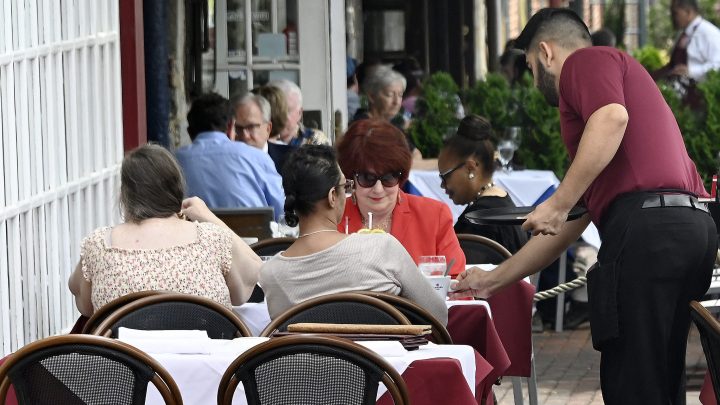
Potential changes in restaurant pay stir mixed reactions

The restaurant industry can be tough. Servers and cooks work on their feet, racing to get orders out when the place is busy. Restaurants themselves have notoriously small margins. The industry and the lives of many who work in it were upended by the pandemic.
An effort is underway that could transform it once again. In a dozen states, restaurants and worker advocates are fighting over how — and how much — tipped workers should be paid by the restaurants that employ them.
Being a waiter is an erratic way to make a living. At least it is for one waiter in Manhattan, New York, whom we’ll call Joe.
“During busy season, I run a full schedule, so that could range from 28 to 40 hours. During the wintertime, when it’s slower, it can go down by a lot, usually like 10 hours a week,” he said. Joe’s employer is “retaliatory,” he said, so he doesn’t want his real name used in this story.
The food at Joe’s restaurant is billed as New American, and the place serves customers against the backdrop of the World Trade Center. The prices are … very New York. A burger costs about $30. Much of Joe’s erratic paycheck goes to something very constant: “If my income was spread evenly year-round, half of my paycheck goes straight to rent,” he said.
In New York, minimum wage is $16 an hour. Like in many states, restaurants aren’t actually responsible for all of that. They can let some of Joe’s tips count toward the minimum wage. In New York City, restaurants have to pay $10.65 and can let tips take care of the remaining $5.35. Usually, the tips more than cover it. “A regular check to me looks like $29 to $33 an hour,” Joe said.
If tips don’t cover it, it’s usually because he’s doing some other nontipped tasks around the restaurant — cleaning or organizing. For those hours, the restaurant is on the hook for the full minimum wage of $16.
This is how things work in 43 states, whose minimum wages range from $16 an hour down to just over $7. This system has different names based on how people feel about it. The legal name is the tip credit system or tipped minimum wage. Saru Jayaraman calls it the sub-minimum wage.
“The sub-minimum wage for tipped workers is a direct legacy of slavery,” Jayaraman said. She’s president of the One Fair Wage campaign, which is pushing to end the tip credit system. “It was created after Emancipation to allow restaurants to hire newly freed Black women, not pay them and force them to live on a new thing that had just arrived from Europe called tips,” she said.
Jayaraman calls the system in which restaurants use tips to cover part of their minimum wage obligation a source of poverty for a workforce that is overwhelmingly women. “It’s also been a source of extreme — the highest rates, really — of sexual harassment of any industry. Because these women have to put up with so much in order to get tips.”
Jayaraman wants all restaurants to pay a full minimum wage, with tips on top, to create a big pay bump for tipped workers. There are bills or ballot measures that would do this in a dozen states, she said, including New York.
“Eliminating the tip credit in New York would be absolutely devastating,” said Andrew Rigie, head of the New York City Hospitality Alliance. According to its survey, 88% of restaurants believe eliminating the tip credit would be a “disaster.”
“If the tip credit is eliminated, in response restaurants would have to significantly increase their prices on consumers, who are already price-sensitive. And that would result in many cases of them maybe tipping less,” he said.
Seven states have long banned the tip credit: Alaska, California, Minnesota, Montana, Nevada, Oregon and Washington. According to data collected from around 100,000 restaurants by payment service provider Toast, people in these states do tip less, but not by much.

California, which does not have a tip credit, was consistently the lowest-tipping state in 2023 at a bit more than 17%. Delaware, which does have a tip credit, consistently tipped the highest — just shy of 22%.
Where Jayaraman sees a source of poverty, Rigie sees a ladder. “This system, because you get the base wage and the tips, has allowed so many tipped workers to earn much, much more than the minimum wage,” he said.
Restaurants and labor advocates trade figures like punches on this point. One Fair Wage points to Bureau of Labor Statistics data that shows a median pay of $14 an hour or $29,000 per year. The National Restaurant Association says the data behind that doesn’t fully capture tips and points to data by payment service providers such as Square showing a median average of $18 an hour.
While some restaurants have attempted to do away with tips and offer a steady wage, only to abandon the effort, others appear to be making it work.
Amid the back and forth, there is a place that can shed light on what might happen if the tip credit were eliminated. Rigie and Jayaraman agree: Look to Washington, D.C., which started phasing out the tip credit last year.
Friday we’ll do just that in the second of our reports on restaurant pay.
There’s a lot happening in the world. Through it all, Marketplace is here for you.
You rely on Marketplace to break down the world’s events and tell you how it affects you in a fact-based, approachable way. We rely on your financial support to keep making that possible.
Your donation today powers the independent journalism that you rely on. For just $5/month, you can help sustain Marketplace so we can keep reporting on the things that matter to you.











